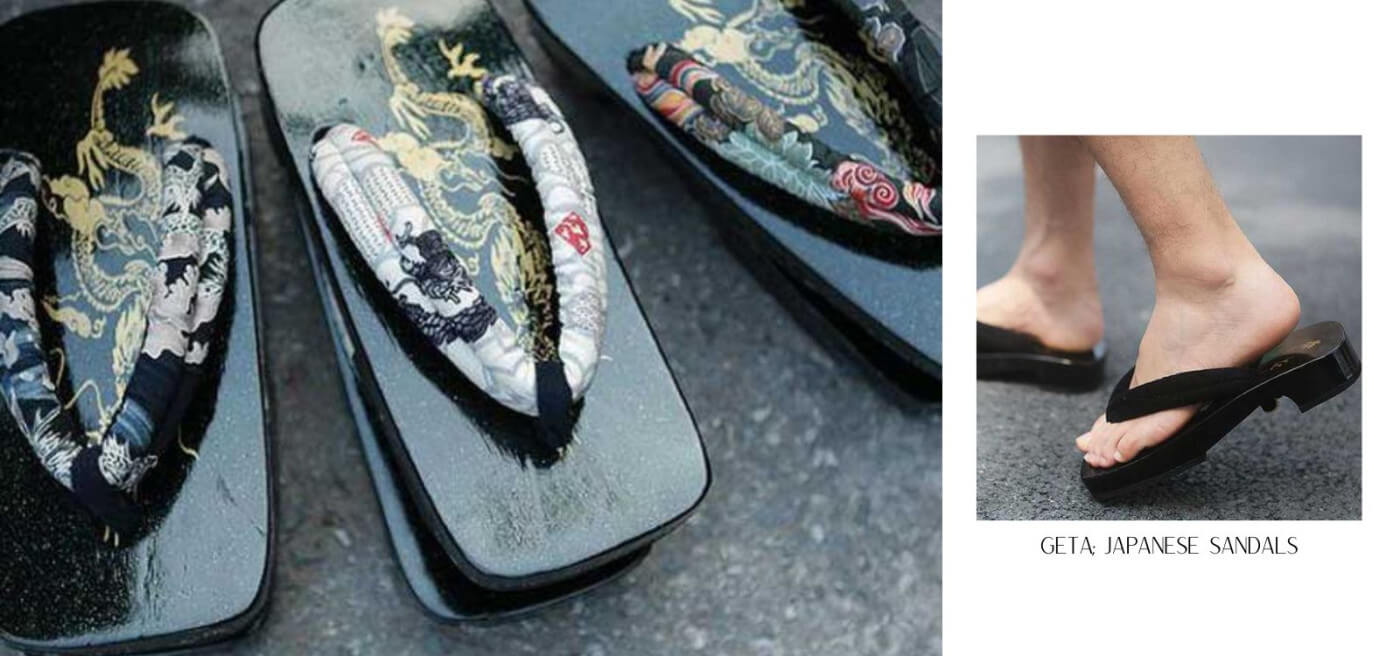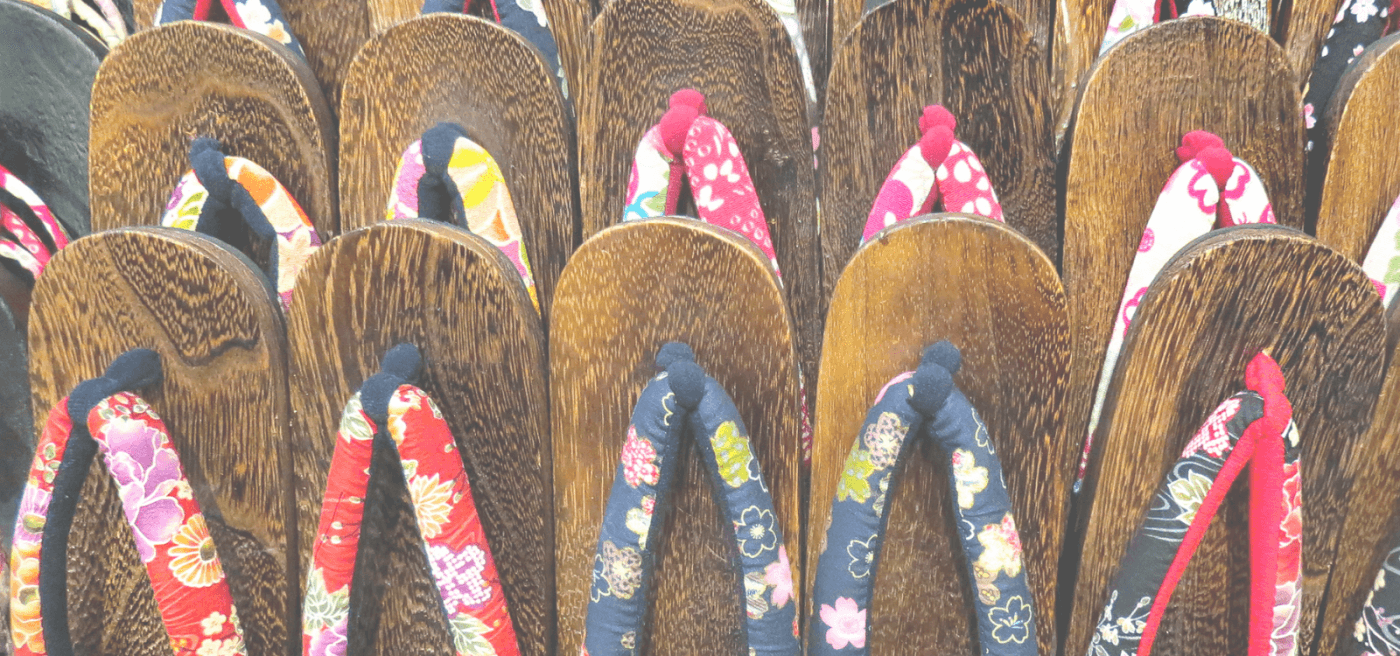Why do the Japanese wear socks with sandals? Knowing the answer is essential to recreating an authentic look with a kimono. Let’s take a look at the two most popular Japanese sandals: Zori and Geta sandals.
Are Traditional Japanese Sandals Comfortable?
We all accept that fashion is sometimes painful. In Japan, women take a more pragmatic approach. They choose from several types of thonged footwear.
Japanese Geta are the traditional open-toed shoes most commonly worn with a kimono. In Japanese culture, these wooden sandals contribute to the graceful walk of the wearer. The reason is that they are challenging to master, as the wearer must shuffle forward.
The common Geta can double as a high heel and can be worn with bare feet. Taking things slowly with these traditional wooden clogs is best. Many Japanese people today reserve them for formal occasions or making a fashion statement rather than everyday wear.
Several other types of sandals are available, and the Setta and Zori are among the most comfortable. These traditional "flip flops" are made from soft materials and are very soft to wear.
You may increase your comfort level by wearing traditional Japanese socks to keep your feet warm. Japanese people often pair Jika Tabi socks, or five-toe socks, during cool weather to protect against the natural wood and keep their feet dry.
How to Wear Japanese Sandals
Why do Japanese wear socks with sandals? Typically, they wear socks to improve comfort. While many Japanese wear toe socks, walking barefoot in Japanese wooden sandals is perfectly acceptable.
You may prefer to wear Geta on your feet after tying all the knots in kimonos. You need not wear Tabi socks with these "flip flops" before you slide them onto your foot.
Most sandals in Japan are similarly easy to wear. You slide on the traditional Japanese sock and then slip into the sandal. Simpler models like the Zori and Setta are easy for beginners to get the hang of.
With Geta, we recommend that women start with no more than a 10-cm-thick sole at first. The higher the heel, the more unwieldy the shoes. Unlike Western clothes, lower is better. When walking, slide your feet rather than trying to lift them.
In the Edo period, women who wore Geta perfected the art of the "kimono walk." They looked extremely elegant gliding along, making these sandals more than a simple fashion trend. They also matched the thong color to that of their sashes.
Another tip is to get the size right. Your feet should not teeter over the front of the shoe, but you should leave a little room in the back. Wearing Tabi can be helpful if you are worried about chafing with new shoes.
Wearing Socks: What Are Japanese Sandals Worn With?
Japanese Geta

$64.90
Ancient Craft Meets Urban Edge – Bold & Timeless Japanese-Geta Elevate your style with these Japanese geta, a fusion of tradition and modern streetwear. Designed for comfort and cultural authenticity, these wooden sandals feature a sleek black lacquered base adorned… read more
Sandal etiquette is simpler than you might think. You need to consider whether there is cold weather, how long you will walk, and your overall comfort. Here, the Japanese are a definite step up on Western clothing.
For the most part, Zori with a pair of Jika Tabi socks works for any formal occasion. Geta is an option that most people in Japan reserve for traditional affairs or photo shoots. Setta is a more casual option suitable for anything but a formal event.
Wearing socks is most common with Zori in traditional Japanese clothing. It's here that the answer to "why do Japanese wear socks with sandals?" becomes apparent.
The original types of Zori were made from straw and were relatively flat. Socks prevented toes from chafing and kept the chill off. The wearer needed socks to protect against the cold and grass chafing the toes.
Modern versions of this shoe are comfortable and may have a white cloth, vinyl, or leather covering. Wearing Tabi socks is now culturally ingrained.
You can also find formal Zori with a thicker base to create height. Today's models may feature slanted heels to resemble high-heel shoes. These advancements have elevated Zori's status to a favorite for formal wear.
The one exception is for a Yukata outfit. You never pair socks with these outfits.
Difference Between Zori and Geta
Geta Sandals
The closest English translation for Geta is “footwear.” They're practical in that they lift your hem out of the dirt but are seldom worn with Tabi socks. Geta shoes are durable because they are made from one block of wood, so your heels are unlikely to break.
Several types are available, with the two-stilt version, or Masa Geta, being the most popular. The number of “teeth” that elevate the shoes may vary, with some looking like smooth, solid platforms.
Tengu Geta has one tooth, and artists usually depict this type as a demon's favorite footwear. Contemporary actors also display their skills by donning these sandals.
Finally, we have Geta with three teeth. They were traditionally worn by only high-class courtesans or Oiran.
Geta’s modern design is very different from the original. Today's soles are thinner and do not feature stilts. There is also more focus on the patterns, many of which feature the colorful, brash flowers of the Okinawan Bingata design school.
Zori Sandals
Traditionally made of straw, Zori today looks very different as well. The most popular type is the Nuno Zori or fabric Zori, woven footwear that is not meant for outside the home. The closest item in Western design is a slipper.
The differences between the Zori and Geta involve comfort, flexibility, and how they are worn. Zori sandals are typically flattering with flexible soles. You walk in them much as you would slipper and usually pair them with Tabi socks.
You can now answer, "Why do Japanese wear socks with sandals?" and know how to wear Geta and Zori sandals. Are you ready to try them out for yourself? At Eiyo Kimono, we have sandals at reasonable prices and a gorgeous range of authentic Tabi socks with a small bell.
Browse our website to find your perfect set and elevate your wardrobe.








